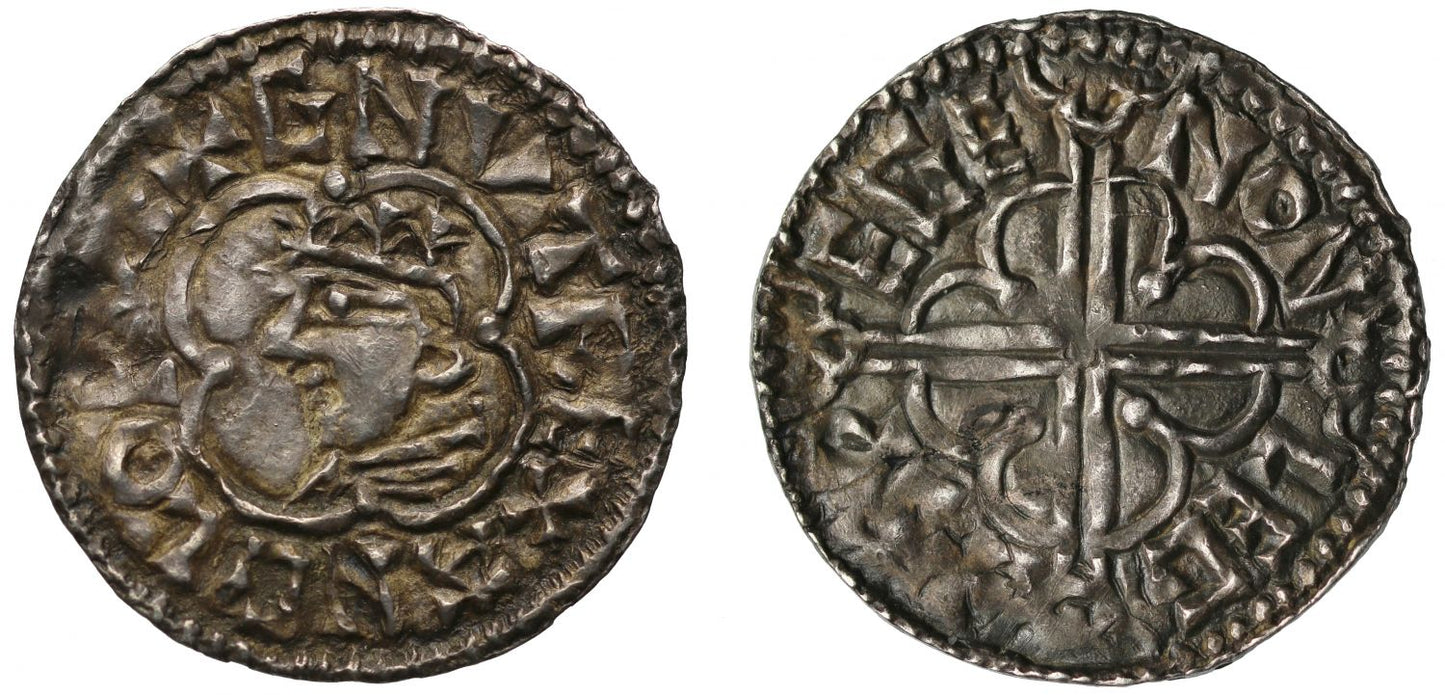FAQs
What makes a coin valuable?
I have coins to sell, what’s the next step?
How will my purchases be shipped?
What happens if I’m not entirely happy with my purchase?
Canute Penny, Quatrefoil type, Chester Mint, moneyer Spegen
Canute (1016-35), silver quatrefoil Penny (c.1017-25), Chester Mint, Moneyer Spegen, crowned and draped bust left within quatrefoil, legend surrounding commences at upper left, +CNVT REX ANGLORX, rev. pellet at centre of voided long cross, over quatrefoil with pellet cusps, legend surrounding, +SP EGE N ON LEG, weight 1.33g (SCBI American 30:488 this coin; BMC type VIII 293; N.781; S.1157). Toned some light die flaws evident, otherwise good very fine with a great portrait.
The legends translate as "Canute King of the English" on obverse and on the reverse "Spegen of Chester."
This coin is of the local Chester style in its later phase, as defined by Blackburn and Lyon in their article "Regional Die Production in Cnut's Quatrefoil Issue." These dies were therefore cut at Chester. Despite Canute being essentially a Viking King from overseas, the coinages of England continued in a similar vein to those of Aethelred II, in that the types changed every six years, meaning there are three main types for this reign, of which the quatrefoil type was the first. According to North there were up to 74 mints in operation with perhaps four other enigmatic places that remain uncertain. North records 26 different moneyers working at Chester in his reign through four types.
Canute could have been as young as 21 when he ascended the English throne after the 28th November 1016 upon the death of Edmund "Ironside" at Oxford. Though Edmund son of Aethelred II had a younger brother and two infant sons his advisers recognized Canute as successor. Though his birth date is not known, Canute was a commander in his Father's army from 1012, and at first had to settle a number of uprisings amongst the nobility and others, which he quelled by maintaining a large army and navy from heavy taxation. He kept Wessex at first for himself whilst dividing up other areas for regional government under trusted Danish allies. Canute had married Aelfgifu daughter of Ealdorman Aelfhelm of Northumbria, but set her aside to marry Aethelred's widow Emma in 1017 who had fled to Normandy, and this latter union helped maintain the political continuity and tradition of English Kingship. Harald of Denmark died childless in 1018 and Canute used his English troops and finance to extend power to Scandanvia making his infant son Harthacanute titular Governor and heir of Denmark. Canute attempted to invade Sweden, and actually took Norway in 1028 having had a pilgrimage to Rome the year before. Canute left his eldest son by Aelfgifu, Swein to rule Norway and was now the most powerful King of England ever at this time and is likely when the apocryphal story of him trying to vainly order the coastal tide to turn and retreat in front of his courtiers emerged. However, Norway was lost by 1034, Canute did not respond, and he passed away suddenly at Shaftesbury in his mid-forties on the 12th November 1035.
The City of Chester lies some 16 miles south of Liverpool near the border with Wales which is why it became a fortified town at the time of the Mercian Kingdom and was later restored by Aethelflaed in 907 after occupation by the Danes in 892. The city later rebelled against William the Conqueror and was ravaged by him in 1070 whereupon he built a castle there. It became a base for William to campaign in Wales and in 1075 the See of Lichfield was moved there, later transferring to Coventry in 1102. The Saxon name an abbreviation of which appears on the coins was LEGACEASTER meaning camp of the Legions and does not start to change to an abbreviation of Chester until the last type of coinage for William I. Minting activity occurs from the reign of Aethelstan until Henry II.
Provenance:
Ex B. A. Seaby Ltd, purchased by Mrs Norweb 1971 see SCBI 30:488.
Ex Mrs E M H Norweb Collection, part IV, Spink Coin Auction 59, 17th June 1987, lot 1230.
Ex Professor G W De Witt, Kunker Auction 137, Germany, 11th March 2008, lot 3093.
Ex Baldwin Auction 77, 27th September 2012, lot 2545.
Ex A H Baldwin, Fixed Price List, Summer 2014, item AS037.
Ex Collection of an English Doctor part II, Sovereign Rarities fixed price list online May 2022.
FAQs
What makes a coin valuable?
I have coins to sell, what’s the next step?
How will my purchases be shipped?
What happens if I’m not entirely happy with my purchase?













